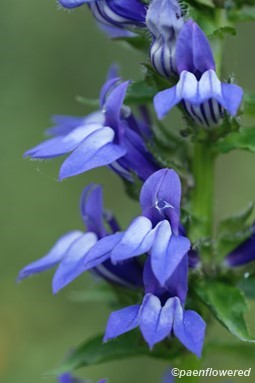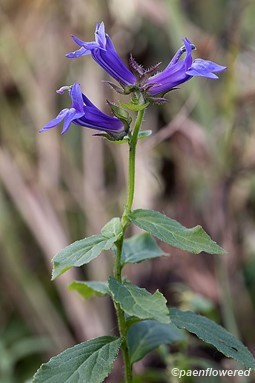Lobelia siphilitica
A blue beauty of the wetlands blooming in late summer
Lobelia siphilitica great blue lobelia
This native perennial wildflower is one of the most beautiful of the late summer flowers. It is the largest of the blue lobelias and produces a dense spike of 1-1 ½″ long tubular and lipped flowers. The plant grows from 1 to 4 feet high on a stem that is almost never branched. The flower spike’s height can vary from 6″ to 2 feet.
The deep blue flowers form in the axils of leafy bracts. They have 2 narrow lobes or 'ears' on top and three wider lobes below—the 'lip'. The corolla is in the form of a tube. Both the corolla tube and the lower lips are streaked with white. The calyx is hairy.
Great blue lobelia normally blooms in August and September. Bumblebees are the major pollinators. The oval or lance-shaped leaves are alternate and 2 to 6 in. long. This wildflower is cultivated in many wildflower gardens because it blooms for a long period of time.
Although the plant is a perennial, it is short-lived. Individual plants last only a few years. It does best with some shade at low woodland and in rich soil with a constant supply of moisture.
Habitat & Range
Frequent in swamps, moist meadows, stream banks, and ditches.
Present throughout the state.
Range: Found throughout eastern and central Canada and United States, except Florida. In the South populations are scattered except in the mountains.
| EMP: | FACW |
|---|---|
| NCNE: | FACW |
Phenology
Flowers August & September.
Characteristics
Inflorescence crowded terminal raceme
Flowers blue or occasionally white; on ascending pedicels growing from leaf axils; 2-lipped tubular corolla, lower lip has 3 lobes, upper lip 2 reduced lobes; calyx hairy
Leaves simple, alternate; oblong or elliptic, sessile
Stems erect, stout
Height 5 feet
Plant Codes
S-rank: S5 (Secure)
G-rank: G5 (Secure)
Ecology
Primary pollinators are bumblebees. Even though most parts of the plant are toxic, deer may browse on this plant.

















Comments
Have you spotted this plant in your area? We'd love to hear about your experience! Share your comments or questions about the plant below. Comments are moderated before posting.